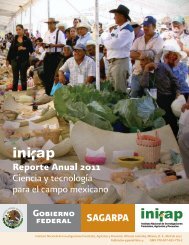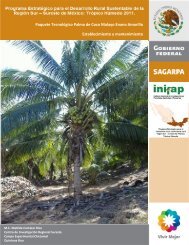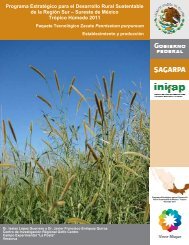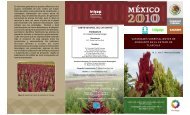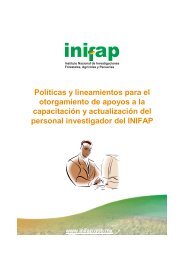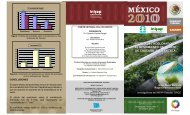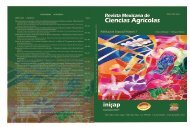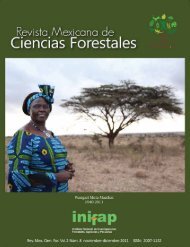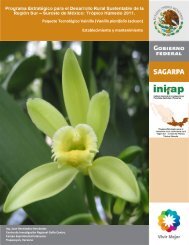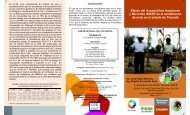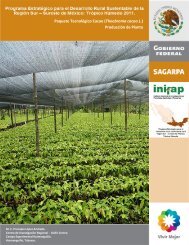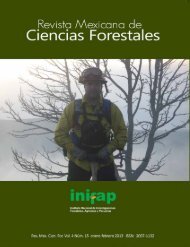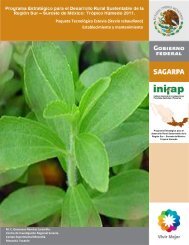Vol. 34 Núm. 3 - Instituto Nacional de Investigaciones Forestales ...
Vol. 34 Núm. 3 - Instituto Nacional de Investigaciones Forestales ...
Vol. 34 Núm. 3 - Instituto Nacional de Investigaciones Forestales ...
Create successful ePaper yourself
Turn your PDF publications into a flip-book with our unique Google optimized e-Paper software.
Soil water content measured by FDR probes and thresholds for drip irrigation management in peach trees 315of electromagnetic techniques are spreading increasinglybecause they facilitate a rapid, safe, non<strong>de</strong>structive,and easily automated estimation of soil water content.Capacitance probes are relatively inexpensive and easy tooperate. Furthermore, the sensor <strong>de</strong>sign is very adaptable,facilitating the <strong>de</strong>velopment of a variety of configurations(Robinson et al., 1998) and the continuous records bycapacitance probes; provi<strong>de</strong> information about the dynamicvariation of the soil water content due to water application,the soil hydraulic properties, plant water uptake and climatic<strong>de</strong>mand (Starr and Paltineanu, 1998; Goldhamer et al.,1999).The aim of this paper was to study the effect of two irrigationtreatments on the volumetric soil water content and to setthe irrigation management thresholds of the soil water store(SWS) in young early-ripening peach trees. This was assessedby analyzing the dynamic in the variations of soil watercontent, measured in continuous by multisensor capacitanceprobes, based on frequency domain reflectometry (FDR)technique placed within the plant root zone.MATERIAL AND METHODSExperimental siteThe present work was conducted during 2004, from fullbloom to leaf senescence, in an experimental 0.8 ha plotlocated in Santomera-Murcia (Spain): 38º 06’ N, 1º 02’W. The soil is stony and shallow, highly calcareous (56%Calcium carbonate), with a clay-loam texture and low organicmatter content (0.<strong>34</strong>%) and cationic exchange capacity of12.6 meq 100 g -1 , classified as Lithic xeric haploxeroll (SoilSurvey Staff, 1998). The bulk <strong>de</strong>nsity of the soil was 1.45Mg m -3 down to 50 cm, but more compacted (1.67 Mg m -3 )at <strong>de</strong>eper layers. The volumetric soil water content was 0.24cm 3 cm -3 at field capacity (θ FC) and 0.15 cm 3 cm -3 at wiltingpoint (θ WP), as <strong>de</strong>termined in undisturbed soil samples witha matric potential of -0.33 and -15 bar respectively usingthe Richards pressure plate technique, which implied anavailable soil water content of 90 mm m -1 .The plant material consisted of three-year-old peachtrees (Prunus persica L. Batsch) cv. "Flordastar", on GF-677 peach rootstock, planted at 5 x 5 m. The trees wereirrigated by a single lateral line per plant row with four selfcompensatingemitters per tree, spaced at 0.5 m and placed1 m from each si<strong>de</strong> of the trunk, providing 2 L h -1 . Irrigationwas scheduled on the basis of weekly estimated ETc andautomatically controlled by an irrigation programmer an<strong>de</strong>lectro-hydraulic valves. The irrigation water volumes weremeasured with in-line water meters.Agro-meteorological data were recor<strong>de</strong>d by an automatedstation located within the peach orchard. During theexperimental period the average maximum and minimumair temperatures were 30.1 and 7.7 ºC, respectively. Theannual reference evapotranspiration (ETo) <strong>de</strong>termined bythe Penman-Monteith equation (Allen et al., 1998) was 1100 mm, with a maximum of 10 mm day -1 in August. Totalrainfall was 440 mm, from which 245 mm occurred duringthe spring season.TreatmentsTo achieve the objective of this work, two irrigation treatmentswere consi<strong>de</strong>red. In the T1 treatment, the trees were irrigatedto 100% of ETc estimated as reference evapotranspiration(ETo), calculated with the Penman-Monteith methodology(Allen et al., 1998), crop coefficients (Table 1) (Doorenbosand Pruitt, 1986; Fereres and Goldhamer, 1990), and thepercentage of ground area sha<strong>de</strong>d by the tree (Fereres andGoldhamer, 1990). The T2 treatment was irrigated at 50%of the T1 with the same irrigation frequency.Treatments were distributed in a completely randomized<strong>de</strong>sign with four replications, each consisting of one row of13 trees. The central nine trees were used for experimentalmeasurements and the others served as guard trees.Soil and plant measurementsThe volumetric soil water content was continuouslymonitored through the soil profile using multisensorcapacitance probes (Cprobe TM ), based on frequency domainreflectometry (FDR) technique. Two probes per treatmentwere used. Each probe, with four sensors at 0.10, 0.20,0.30 and 0.50 m <strong>de</strong>pth, was installed perpendicular to theemitters’s line and at 10 cm from it, within the wetted area ofthe first emitter of a randomly selected peach tree. An emittergauge was installed to monitor the soil water inputs. Both,the capacitance probe and the rain gauge were connected to aradio transmission unit which registered the average of threemeasurements every 15 min. The multisensor capacitanceprobes were properly installed within the active root systemzone and the soil water distribution by the emitters washighly uniform.



